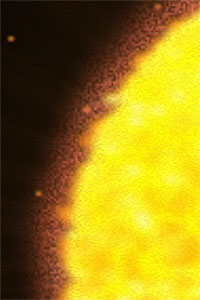 |
|
|
|
You are in: Future Technologies : Helium-3 Power Generation
Helium-3 Power Generation
Helium-3 (He3) is gas that has the potential to be used as a fuel in future nuclear fusion power plants. There is very little helium-3 available on the Earth. However, there are thought to be significant supplies on the Moon. Several governments have subsequently signalled their intention to go to the Moon to mine helium-3 as a fuel supply. Such plans may come to fruition within the next two to three decades and trigger a new Space Race. In addition to the information below, you can also find out more about this topic in my Mining the Moon video or in my BBC interview here. There is also a good article by Fabrizio Bozzato in this June 2014 article for The Diplomat, which in turn is based on his extensive and excellent paper here. There is also a very good recent article here. You may also want to checkout my broader page on resources from space. Helium-3 and Nuclear FusionTo provide a little background -- and without getting deeply into the science -- all nuclear power plants use a nuclear reaction to produce heat. This is used to turn water into steam that then drives a turbine to produce electricity. Current nuclear power plants have nuclear fission reactors in which uranium nuclei are split part. This releases energy, but also radioactivity and spent nuclear fuel that is reprocessed into uranium, plutonium and radioactive waste which has to be safety stored, effectively indefinitely. An overview of this nuclear fuel cycle can be found here. For over 40 years scientists have been working to create nuclear power from nuclear fusion rather than nuclear fission. In current nuclear fusion reactors, the hydrogen isotopes tritium and deuterium are used as the fuel, with atomic energy released when their nuclei fuse to create helium and a neutron. Nuclear fusion effectively makes use of the same energy source that fuels the Sun and other stars, and does not produce the radioactivity and nuclear waste that is the by-product of current nuclear fission power generation. However, the so-termed "fast" neutrons released by nuclear fusion reactors fuelled by tritium and deuterium lead to significant energy loss and are extremely difficult to contain. One potential solution may be to use helium-3 and deuterium as the fuels in "aneutronic" (power without neutrons) fusion reactors. The involved nuclear reaction here when helium-3 and deuterium fuse creates normal helium and a proton, which wastes less energy and is easier to contain. Nuclear fusion reactors using helium-3 could therefore provide a highly efficient form of nuclear power with virtually no waste and no radiation. A short wall chart explaining this in more detail can be found here. The aforementioned fission and fusion nuclear reactions are also illustrated in animations in my Mining the Moon video.
Mining Helium-3 on the MoonOne of many problems associated with using helium-3 to create energy via nuclear fusion is that, at least on the Earth, helium-3 is very, very rare indeed. Helium-3 is produced as a by-product of the maintenance of nuclear weapons, which could net a supply of around 15Kg a year. Helium-3 is, however, emitted by the Sun within its solar winds. Our atmosphere prevents any of this helium-3 arriving on the Earth. However, as it does not have an atmosphere, there is nothing to stop helium-3 arriving on the surface of the Moon and being absorbed by the lunar soil. As a result, it has been estimated that there are around 1,100,000 metric tonnes of helium-3 on the surface of the Moon down to a depth of a few metres. This helium-3 could potentially be extracted by heating the lunar dust to around 600 degrees C, before bringing it back to the Earth to fuel a new generation of nuclear fusion power plants. As reported in an Artemis Project paper, about 25 tonnes of helium-3 -- or a fully-loaded Space Shuttle cargo bay's worth -- could power the United States for a year. This means that helium-3 has a potential economic value in the order of $3bn a tonne -- making it the only thing remotely economically viable to consider mining from the Moon given current and likely-near-future space travel technologies and capabilities. Due to the above it is perhaps hardly surprising that a serious interest is being taken in lunar helium-3. In 2006 Nikolai Sevastyanov, head of the Russian space corporation Energia, was reported to have said that Russia is planning to mine lunar helium-3, with a permanent Moon base to be established by 2015 and industrial-scale helium-3 production to commence by 2020. This clearly is not going to happen! American plans from the early noughties to "establish a permanent base on one of the Moon's poles by 2024", with helium-3 signalled as one of the reasons behind this mission, are also sadly likely to come to nothing. The above noted, China's Lunar Exploration Programme is proceeding apace, and is being led by a scientist with a strong belied in potential helium-3 lunar mining. In December 2013, China managed to land a robot lander on the Moon, so successfully completing stage 3 of its Lunar Exploration Programme. By the end of 2017, the fifth and final stage of the current programme has the intention of sending a robotic craft to the Moon that will return lunar rocks to the Earth. If all goes well, a manned programme may follow in the 2020s, so laying the potential foundation for China to mine for helium-3 on the Moon in the 2030s or beyond . . . A Flower in the Darkness?The subject of mining helium-3 on the Moon as a fuel for future clean, safe nuclear power plants is a fascinating one that raises many questions. Some of these questions are highly technical, and relate to the feasibility of the involved nuclear physics. Other questions concern the not inconsiderable practicalities associated with getting to the Moon, mining and super-heating large quantities of lunar rock (Space.com have reported a suggestion of roughly one million tons of lunar soil being needed to be mined and processed for every 70 tonnes of helium-3 yield), and then getting the precious cargo back to the Earth. However, the far more interesting questions arguably relate to why this is a topic that is receiving so little media and public attention. As noted above, several of the largest governments on the planet have on various occasions made announcements that they are either actively considering or would like to go to the Moon to mine helium-3. Whether or not the science will actually work, this is surely major news. Given that public debates concerning the construction of future nuclear fission power plants and even wind farms now rage with great vigour and a high media profile, why helium-3 power plants as part of a potential future energy strategy are rarely if ever even mentioned is exceptionally hard to fathom. Nobody is trying to hide the potential of future lunar helium-3 power generation. However, like a rose in a dark room, there is a potential danger that something of beauty will fail to gain the light it requires if more attention does not start to be languished on what could end up as a very big part of the solution to Peak Oil and other fossil fuel resource depletion, not to mention climate change. You may also now want to read and view my broader and more recent content on Resources from Space. Return to Future Technologies. |
 Helium-3 has been emitted by the Sun and absorbed by Moon rock for billions of years. 
Mining the Moon video  Learn more about helium-3 lunar mining in "The Next Big Thing". |
|
|